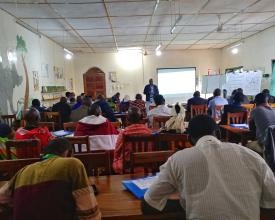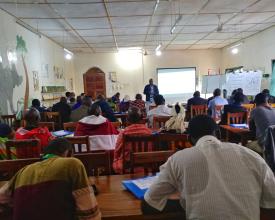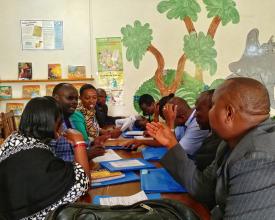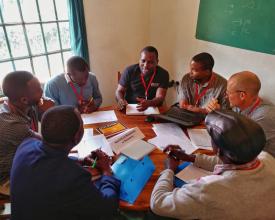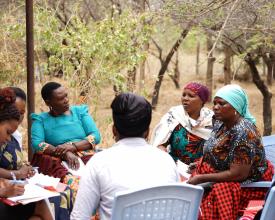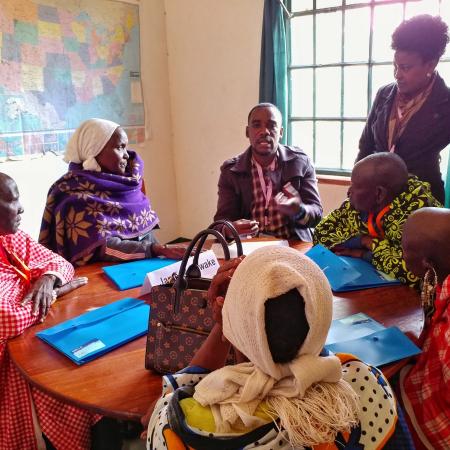
Site level Assessment of Governance and Equity (SAGE) in Makame and Burunge Wildlife Management Areas (WMAs) located in the Northern part of Tanzania
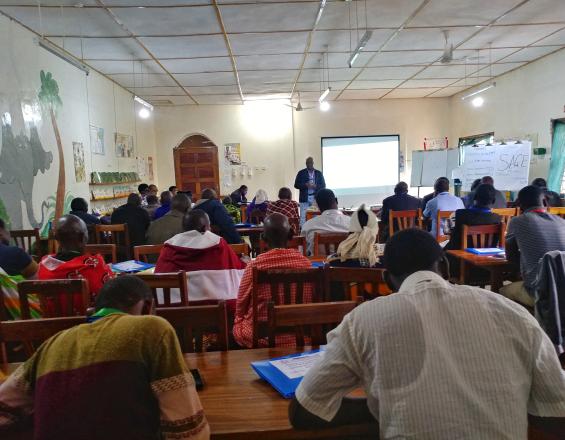
Fundamental to a sustainable conservation area is good governance, ensuring that leadership is effective, can hold management accountable and that benefits are shared equitably.
The project focused on assessing the quality of governance for two Wildlife Management Areas (WMAs) namely Makame and Burunge located in the Northern part of Tanzania using the SAGE methodology. SAGE uses a stakeholder-led self-assessment process to assess the quality of governance and equity using a framework of ten principles of effective and equitable governance. Key actors in the WMA attended the workshop.Their insightful discussions provided the WMA leadership with rich recommendations on where to put more effort in order to improve governance and equity.
The recommendations that came out of the workshop were incorporated into the long-term plans for both WMAs to improve their governance and equity as well as inform Honeyguide on priorities in designing WMA governance capacity building programs.
Contexto
Défis à relever
Fundamental to a sustainable conservation area is good governance, making sure that the leadership is effective, can hold the management accountable and ensuring that benefits - ecological, social and economic - are shared equitably.
With the SAGE assessment, communities were able to provide their powerful comments and feedback about their own governance weaknesses. The general highlighted ones are: poor involvement of key stakeholders in WMA planning (eg. Investors), poor communication between WMA and community members, poor separation of governance and management functions and poor representation of local community leaders.
Ubicación
Procesar
Summary of the process
For the effective assessment of governance for both WMAs, good preparation was required whereby site profiling was done which highlighted the key actors, governance type, key threats to conservation of the WMA resulting from the activities of people, key rights of local people, existing governance structures etc. All the information gathered enabled the assessment to be tailored to the local environment where the WMA operates.
This was followed by a stakeholder analysis whereby with the cooperation from WMA management and the government officials, key WMA stakeholders were identified and invited to the workshop followed by introductory training to facilitators and key actors.
The actual SAGE assessment took two days whereby different actor groups were brought together to discuss the ten different aspects of the governance and equity of their WMA and choose the response that most closely aligns with their opinion. The SAGE assessment results from different actor groups were shared and discussed openly.
Based on the SAGE assessment results, recommendations for actions to improve governance and equity of the WMA were provided by key stakeholders and an action plan was prepared to allow following up.
Building Blocks
1. Stakeholder Engagement
The SAGE methodology uses a stakeholder-led, self-assessment process to assess the quality of governance and equity.
The initial activity started with the identification of the key actor groups who have significant interest in the WMA or have power to influence conservation activities likely to affect conservation either positively or negatively e.g benefit sharing, livelihood projects supporting conservation and environmentally damaging activities whereby five different actor groups were identified and engaged as participants in the SAGE process. These actor groups represented members of the AA (Authorized Association), the board, representatives from men and women community, representatives from government, investors and other partners working in the same area.
Engagement of these key actor groups was the very significant success of the SAGE process because they have the better knowledge of the local environment and all the underlining activities going around in their WMA and they provided the right assessment and recommendation of their WMA.
Enabling factors
The identification of the key actor groups to be engaged in the SAGE process was done successfully following the information obtained through the meeting held at the WMA offices before the SAGE workshop whereby the WMA management, members of Authorized Association and the board, key influential people, partners and government official were able to identify other important actors within communities who should be engaged in the SAGE process including traditional leaders.
Lesson learned
The involvement of different partners working in the same area or have worked in the same area, village leaders and government officials assisted in the provision of important information which widened our scope of identifying and engaging important key actors in the WMA.
2. Identification of the key areas of concern (Data Collection/ SAGE process)
The main SAGE workshop started with pre-workshop orientation of participants and facilitators followed by two days assessment. During these sessions participants were provided with an initial overview of the SAGE process through presentations, followed by printed score cards for each of the 39 SAGE questions based on the ten principles of good governance and equity, from which each stakeholder group discussed the question, scored the results and presented to the plenary. The major differences in opinion between the different stakeholder groups could likely indicate governance challenges therefore these differences were well noted and justifications of their scores were provided.
This process continued by provision of ideas for action from each stakeholder group on the areas where the major differences occurred. For example, differences of opinion on benefit sharing among different actor groups may occur because the different stakeholder groups may have different information or different understandings of the available information. Therefore, for this to be easily resolved, recommendations for better transparency and sharing of proper information among stakeholder groups could be identified as a recommended solution as well as the plans for its implementation put in place.
Enabling factors
Assessing the governance and equity at the site level can be a complex task that requires careful consideration of several factors so as to ensure its success. Based on the SAGE assessment done, consideration of the following made the SAGE process successful;
- Proper identification and engagement of key stakeholders.
- Openness and transparency of key stakeholders during the whole assessment process.
- The willingness of key stakeholders to address the identified disparities and inequities, and be willing to take the necessary corrective measures.
Lesson learned
SAGE methodology covers a gap in the conservation toolbox, providing self-assessment, multi stakeholder opinions, and a platform to iron out strengths and weaknesses of protected areas in a safe and participatory manner
SAGE provides information for planning, strategy, reporting and policy development at system, national, and global levels. Honeyguide has incorporated SAGE as the main tool to initiate discussions, assess, diagnose and inform governance capacity building initiatives of WMAs in Tanzania
Like any other participatory approaches, advanced planning is required to make SAGE useful and successful. This includes advance invitations and follow-ups, careful venue selection, as well as choosing appropriate facilitators with a balance between experience, credibility, language, familiarity of the local context, non-conflicts of interests and other logistical planning
We also learned that the success of the assessment depends much on the familiarity of the facilitators to the assessment questions. Sufficient time needs to be invested in preworkshop orientation of facilitator
3. Action planning based on the outcome of the SAGE assessment
Development of an action plan after the SAGE process was very crucial as it ensured that recommendations provided in the SAGE process were addressed in a systematic and targeted manner whereby key stakeholders who participated in the SAGE process were also engaged in the action planning process hence, they drew the roadmap for implementation of those recommendations.
In addition, recommendations which came out of the SAGE process informed Honeyguide on areas of priority in designing WMA governance capacity building programs.
Enabling factors
The overall successful preparation of an action plan after the SAGE process required the following;
- A clear understanding of the assessment findings and recommendations provided
- Clear goals and objectives to be achieved
- Strong leadership and coordination with key stakeholders
- Adequate resources
- Willingness and commitment from all key stakeholders.
Lesson learned
Overall success of the action planning phase based on the outcome of SAGE process provided an opportunity to learn important lessons related to;
- Keen selection and active engagement of key stakeholders in the planning process
- Thorough understanding of the local context
- Effective prioritization and goal setting by all key stakeholders
- Inclusiveness of all key stakeholders in adequate resource mobilization
These lessons learned can be used as a good source of information to future development planning and programming organs of the WMA and can help to ensure that development interventions are effective, inclusive, and sustainable over the long term.
Impacts
At both SAGE assessments conducted in Makame and Burunge WMA, participants reported that the activity provided them a safe space and platform to talk about their governance issues that they would not otherwise address in any other meeting
In Makame WMA, representatives of local traditional leaders are included in quarterly WMA planning meetings and women are included in decision making processes - something that was not done prior to the SAGE exercise.
There is better separation of governance and management functions in Burunge WMA after a lengthy discussion about the different roles of the two major WMA bodies. This was identified as an issue during SAGE and a follow up training with Honeyguide was conducted to clarify different roles and responsibilities.
There is better and more frequent communications from the WMA to its stakeholders especially the private sector stakeholders and communities, the two groups that were found mostly uninformed about what was going on with the WMAs.
Recommendations from SAGE were used to feed into WMA work plans as well as informing Honeyguide (an NGO) on areas of priority in designing WMA governance capacity building programs
Honeyguide has continued to engage with IIED’s SAGE development team to contribute to the improvement of SAGE methodology and questionnaire with lessons from the WMA pilots
Beneficiaries
- Local communities (men, women, youth and children)
- Authorized Association (AA) and the WMA board
- Village leaders
- Investors
- Different partners working in the same area
- Government officials.
- Management of the respective WMAs
Sustainable Development Goals
Story

“This has been the most powerful discussion we have ever had since the establishment of our WMA” said Supuk Olekao, currently serving as Makame WMA manager who has seen the WMA since its establishment twelve years ago
In Tanzania, Wildlife Management Areas (WMA) are community-owned protected areas that are managed by communities. They often form buffer zones around conservation areas, and communities manage and use the land, natural resources, and wildlife to support their livelihoods
Benefits to communities vary depending on a community’s specific resources and needs. In Makame and Burunge for example, carbon offset, hunting blocks and wildlife tourism revenues, respectively, fund schools, hospitals and provide other social benefits to communities. At the same time pastoralist communities in Makame WMA benefit from grazing rights. The WMAs ensure the areas are protected from charcoal burning, encroachment and poaching, among other
At Honeyguide, our goal is to demonstrate successfully-run, locally led conservation initiatives, using WMAs as the main model of CBNRM in Tanzania. To do this we need capable and inclusive institutional management and governance at WMA level. SAGE has given us a perfect approach to spark governance discussions in WMAs
Insightful debate like discussions during SAGE led to targeted governance improvements, resulting in impactful changes in WMA practices: In Makame WMA, representatives of local traditional leaders are now included in WMA planning meetings, there is better separation of governance and management functions in Burunge WMA ,there is better, more frequent communications from the WMA to its stakeholders especially the private sector stakeholders and communities in Burunge WMA and Honeyguide has continued to engage with IIED’s SAGE development team to contribute to the improvement of the SAGE methodology and questionnaire with lessons from the WMA pilots
Honeyguide believes that supporting cohesive and equitable governance and management of WMAs will lead towards social, ecological and economic sustainability. The SAGE tool offers an opportunity to pause and reflect on the direction and purpose of the WMA and adjust course to meet these broader goals. In so doing, the tool leverages communities’ knowledge and interests for outcomes that are equitable and sustainable for them and the lands they protect.
‘Communities are eager to continue working with Honeyguide to see their work through’ said maasai elder Makame WMA
